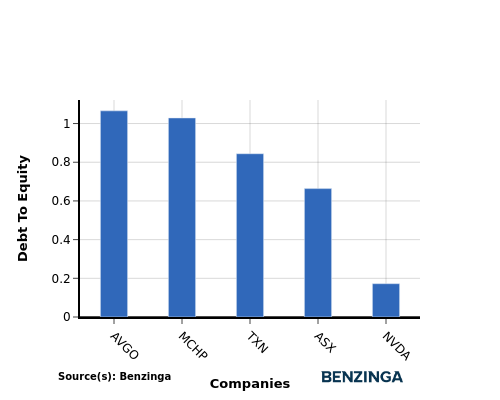In today's rapidly changing and fiercely competitive business landscape, it is essential for investors and industry enthusiasts to thoroughly analyze companies. In this article, we will conduct a comprehensive industry comparison, evaluating NVIDIA NVDA against its key competitors in the Semiconductors & Semiconductor Equipment industry. By examining key financial metrics, market position, and growth prospects, we aim to provide valuable insights for investors and shed light on company's performance within the industry.
NVIDIA Background
Nvidia is a leading developer of graphics processing units. Traditionally, GPUs were used to enhance the experience on computing platforms, most notably in gaming applications on PCs. GPU use cases have since emerged as important semiconductors used in artificial intelligence. Nvidia not only offers AI GPUs, but also a software platform, Cuda, used for AI model development and training. Nvidia is also expanding its data center networking solutions, helping to tie GPUs together to handle complex workloads.
| Company | P/E | P/B | P/S | ROE | EBITDA (in billions) | Gross Profit (in billions) | Revenue Growth |
|---|---|---|---|---|---|---|---|
| NVIDIA Corp | 68.80 | 61.90 | 37.95 | 30.94% | $19.71 | $22.57 | 122.4% |
| Taiwan Semiconductor Manufacturing Co Ltd | 30.23 | 8.02 | 11.98 | 8.36% | $360.77 | $439.35 | 38.95% |
| Broadcom Inc | 137.63 | 12.12 | 16.87 | -2.77% | $6.39 | $8.36 | 47.27% |
| Advanced Micro Devices Inc | 122.87 | 3.95 | 9.34 | 1.36% | $1.55 | $3.42 | 17.57% |
| Texas Instruments Inc | 38.29 | 10.88 | 12.04 | 7.86% | $2.09 | $2.47 | -8.41% |
| Qualcomm Inc | 18.34 | 6.93 | 4.76 | 11.46% | $3.21 | $5.78 | 18.69% |
| ARM Holdings PLC | 225.42 | 23.84 | 40.98 | 1.83% | $0.11 | $0.81 | 4.71% |
| Micron Technology Inc | 141.69 | 2.44 | 4.42 | 1.99% | $3.63 | $2.74 | 93.27% |
| Analog Devices Inc | 63.93 | 2.99 | 10.92 | 1.11% | $1.04 | $1.31 | -24.84% |
| Microchip Technology Inc | 45.56 | 5.61 | 6.49 | 1.24% | $0.34 | $0.67 | -48.37% |
| ON Semiconductor Corp | 16.63 | 3.32 | 3.95 | 4.75% | $0.63 | $0.8 | -19.21% |
| Monolithic Power Systems Inc | 65.03 | 11.96 | 13.84 | 6.35% | $0.17 | $0.34 | 30.59% |
| STMicroelectronics NV | 10.74 | 1.34 | 1.73 | 1.98% | $0.74 | $1.23 | -26.63% |
| First Solar Inc | 16.81 | 2.75 | 5.45 | 4.22% | $0.45 | $0.45 | 10.81% |
| ASE Technology Holding Co Ltd | 19.07 | 2.18 | 1.15 | 3.16% | $28.59 | $26.43 | 3.85% |
| United Microelectronics Corp | 10.58 | 1.57 | 2.47 | 3.76% | $27.9 | $19.98 | 0.89% |
| Skyworks Solutions Inc | 17.36 | 2.12 | 3.10 | 1.9% | $0.25 | $0.36 | -15.47% |
| MACOM Technology Solutions Holdings Inc | 121.88 | 8.12 | 12.78 | 2.67% | $0.04 | $0.1 | 5.37% |
| Universal Display Corp | 33.43 | 4.98 | 12.32 | 4.29% | $0.08 | $0.13 | 14.57% |
| Lattice Semiconductor Corp | 49.64 | 9.93 | 12.47 | 1.03% | $0.03 | $0.09 | -33.87% |
| Average | 62.38 | 6.58 | 9.85 | 3.5% | $23.05 | $27.1 | 5.78% |
By analyzing NVIDIA, we can infer the following trends:
-
At 68.8, the stock's Price to Earnings ratio significantly exceeds the industry average by 1.1x, suggesting a premium valuation relative to industry peers.
-
It could be trading at a premium in relation to its book value, as indicated by its Price to Book ratio of 61.9 which exceeds the industry average by 9.41x.
-
With a relatively high Price to Sales ratio of 37.95, which is 3.85x the industry average, the stock might be considered overvalued based on sales performance.
-
With a Return on Equity (ROE) of 30.94% that is 27.44% above the industry average, it appears that the company exhibits efficient use of equity to generate profits.
-
The company has lower Earnings Before Interest, Taxes, Depreciation, and Amortization (EBITDA) of $19.71 Billion, which is 0.86x below the industry average. This potentially indicates lower profitability or financial challenges.
-
With lower gross profit of $22.57 Billion, which indicates 0.83x below the industry average, the company may experience lower revenue after accounting for production costs.
-
The company is experiencing remarkable revenue growth, with a rate of 122.4%, outperforming the industry average of 5.78%.
Debt To Equity Ratio

The debt-to-equity (D/E) ratio is an important measure to assess the financial structure and risk profile of a company.
Considering the debt-to-equity ratio in industry comparisons allows for a concise evaluation of a company's financial health and risk profile, aiding in informed decision-making.
By evaluating NVIDIA against its top 4 peers in terms of the Debt-to-Equity ratio, the following observations arise:
-
NVIDIA has a stronger financial position compared to its top 4 peers, as evidenced by its lower debt-to-equity ratio of 0.17.
-
This suggests that the company has a more favorable balance between debt and equity, which can be perceived as a positive indicator by investors.
Key Takeaways
For NVIDIA, the PE, PB, and PS ratios are all high compared to its peers in the Semiconductors & Semiconductor Equipment industry, indicating that the stock may be overvalued based on these metrics. On the other hand, the high ROE and revenue growth suggest strong performance and potential for future growth. However, the low EBITDA and gross profit numbers may raise concerns about the company's operational efficiency and profitability compared to industry peers.
This article was generated by Benzinga's automated content engine and reviewed by an editor.
© 2024 Benzinga.com. Benzinga does not provide investment advice. All rights reserved.







